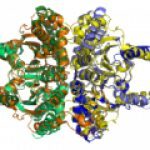Link to Pubmed [PMID] – 12087185
Nucleic Acids Res. 2002 Jul;30(13):2987-94
We investigated 53 complete bacterial chromosomes for intrachromosomal repeats. In previous studies on eukaryote chromosomes, we proposed a model for the dynamics of repeats based on the continuous genesis of tandem repeats, followed by an active process of high deletion rate, counteracted by rearrangement events that may prevent the repeats from being deleted. The present study of long repeats in the genomes of Bacteria and Archaea suggests that our model of interspersed repeats dynamics may apply to them. Thus the duplication process might be a consequence of very ancient mechanisms shared by all three domains. Moreover, we show that there is a strong negative correlation between nucleotide composition bias and the repeat density of genomes. We hypothesise that in highly biased genomes, non-duplicated small repeats arise more frequently by random effects and are used as primers for duplication mechanisms, leading to a higher density of large repeats.


